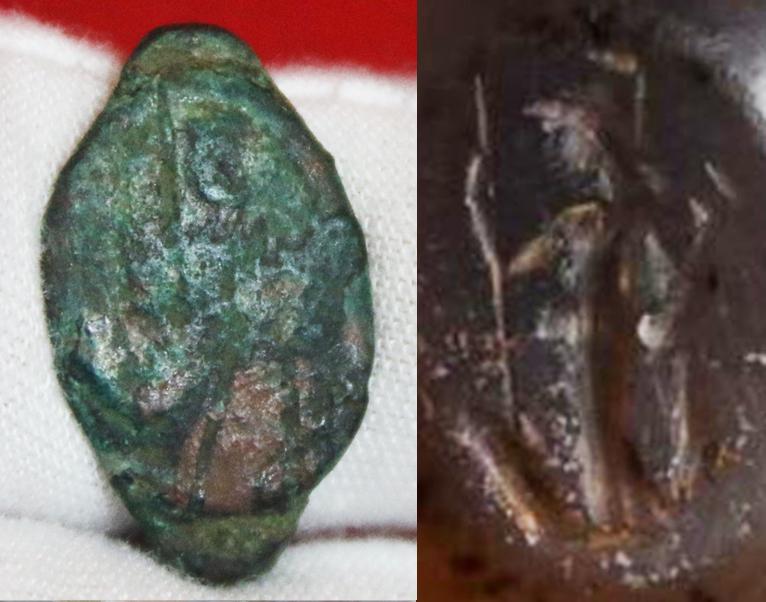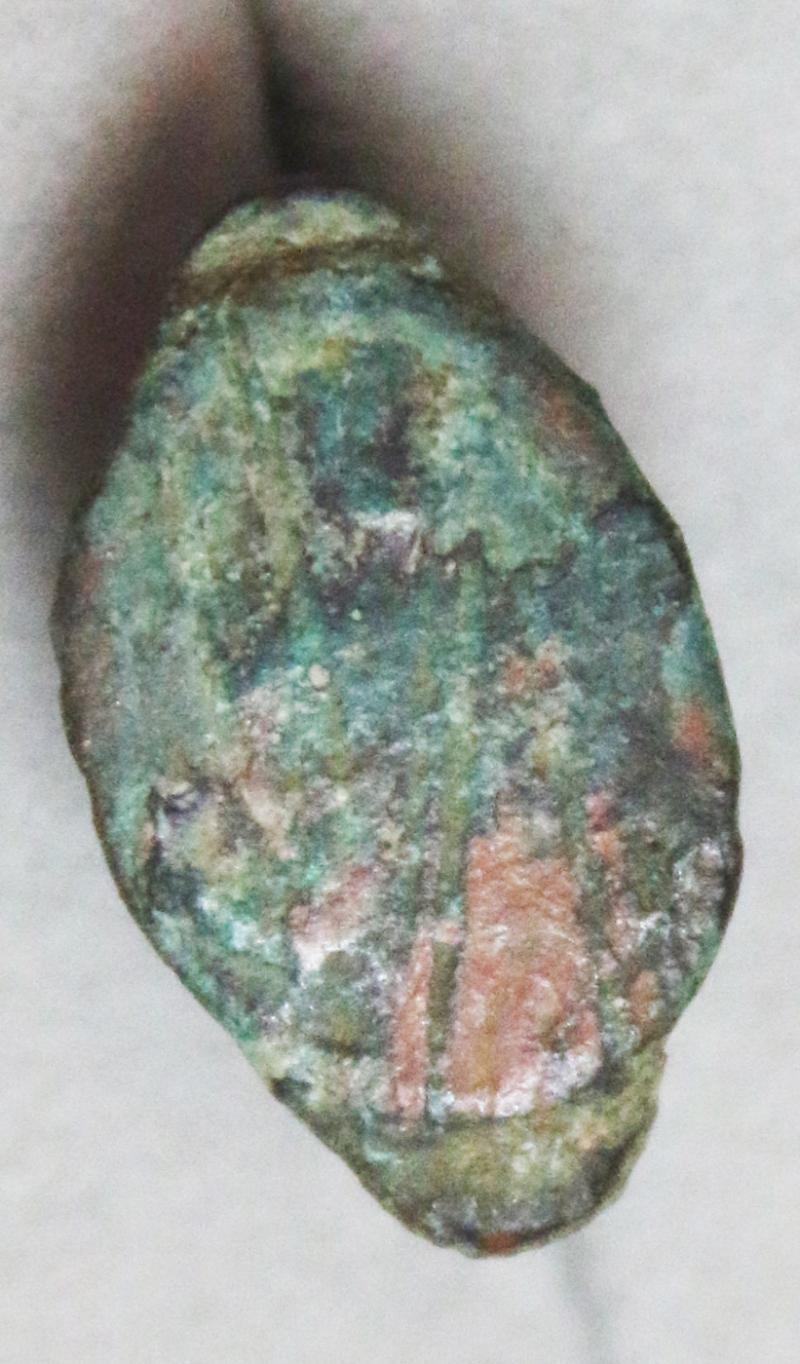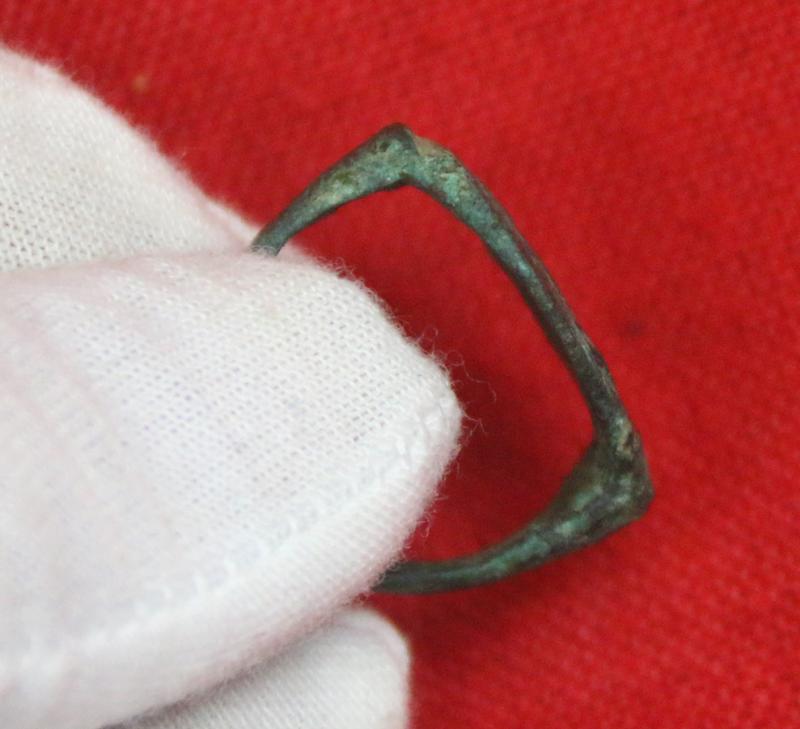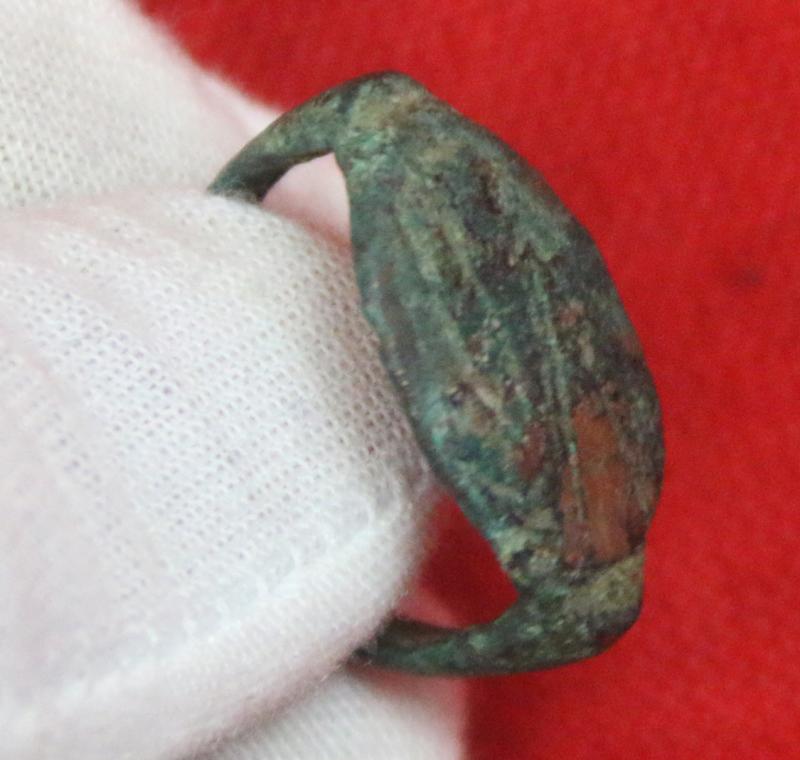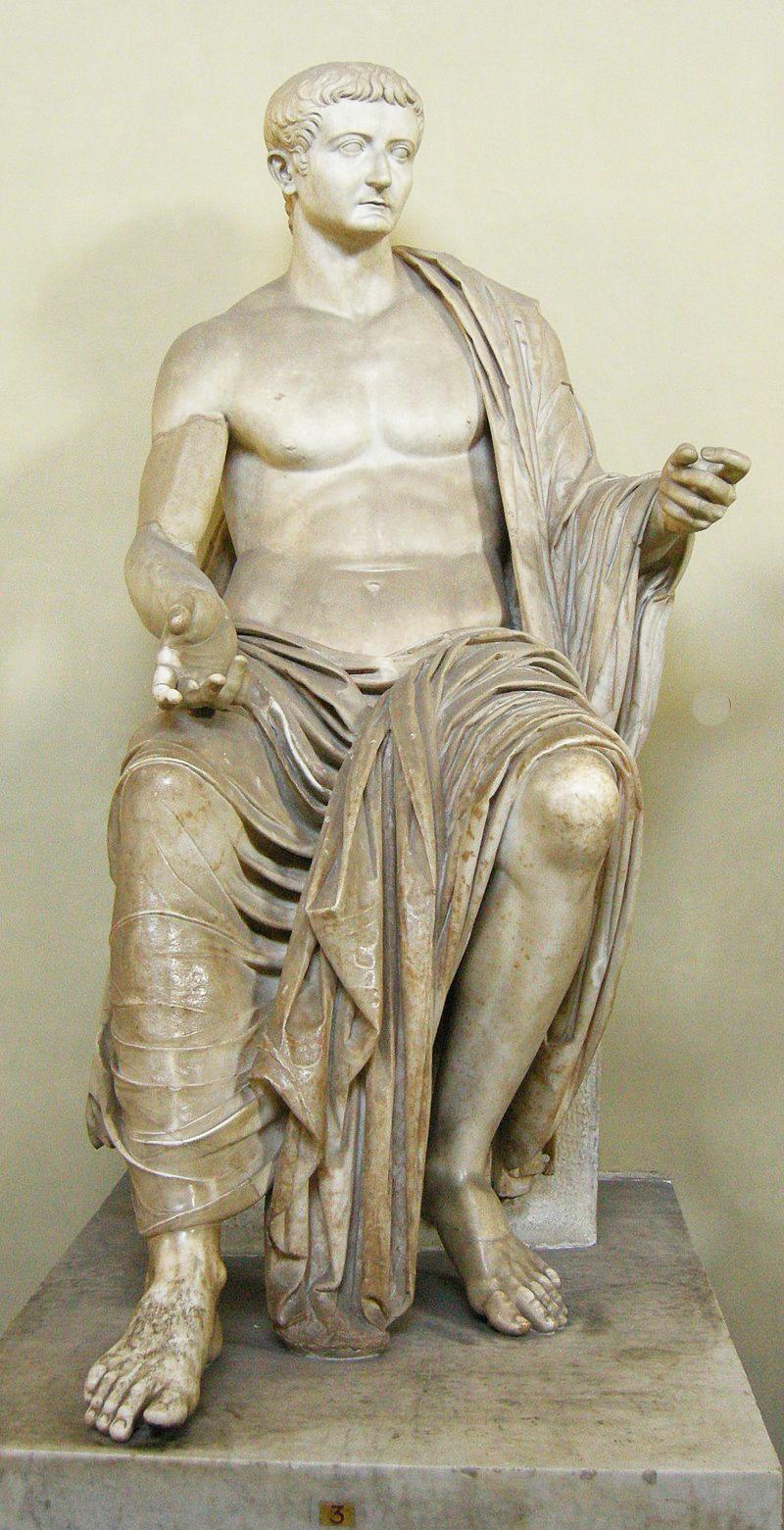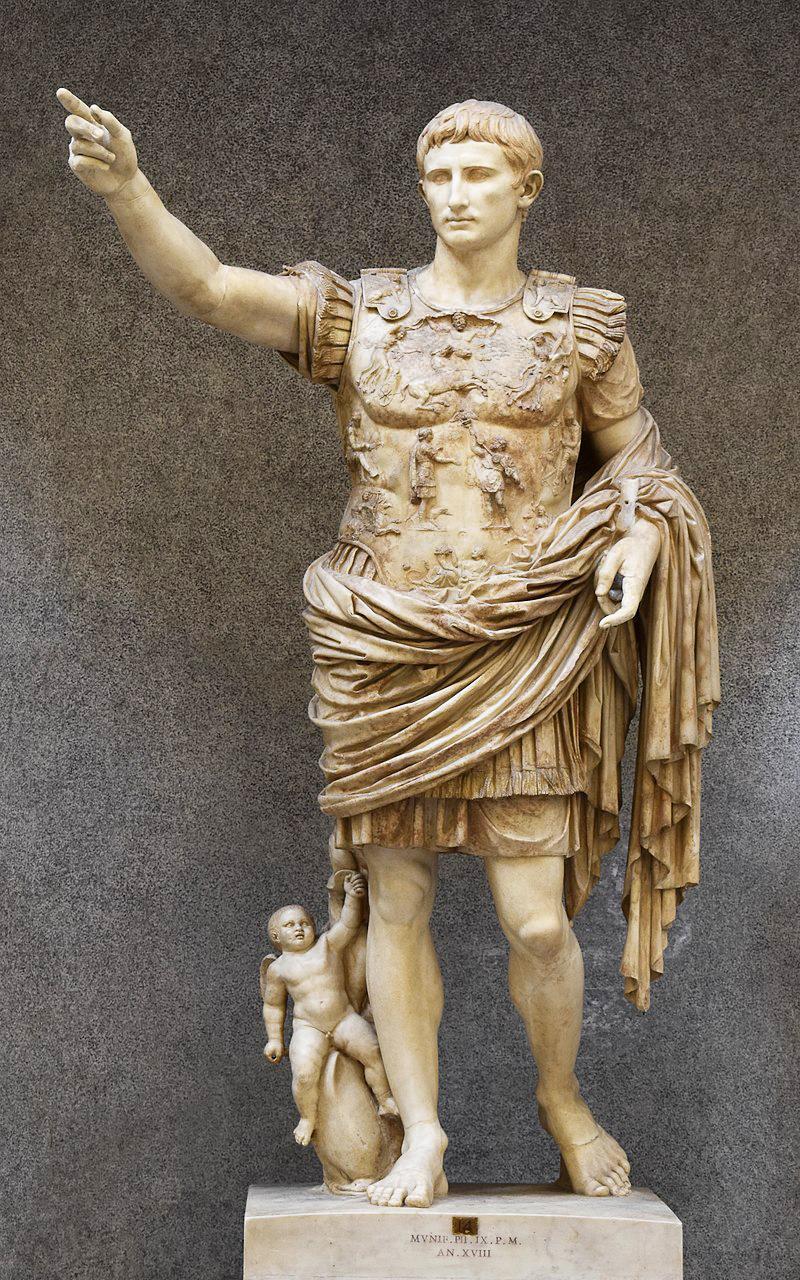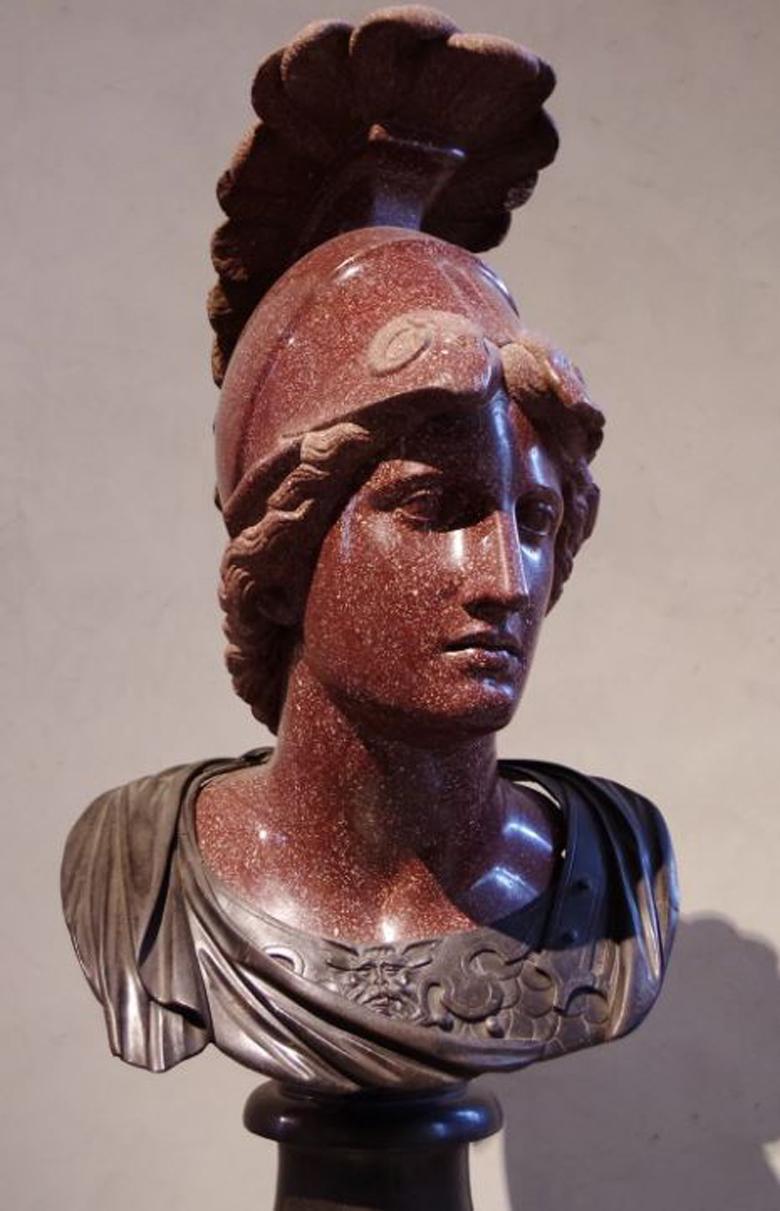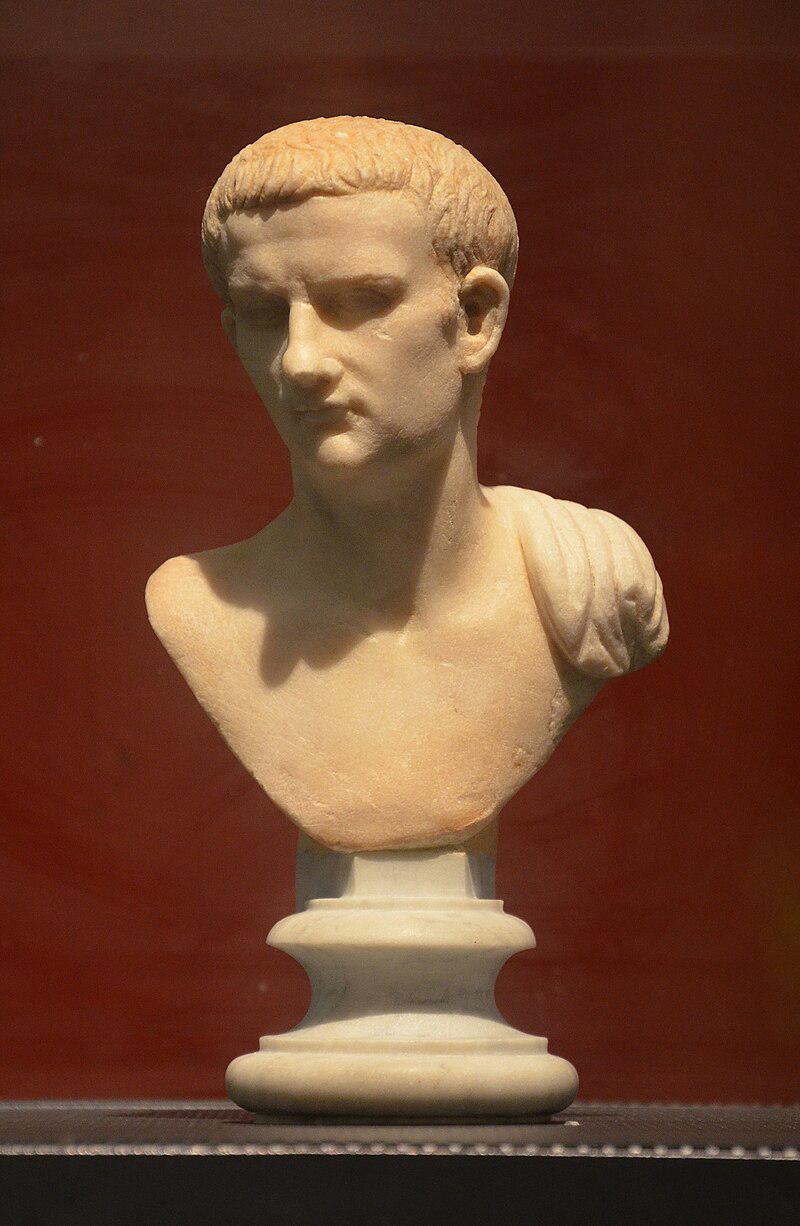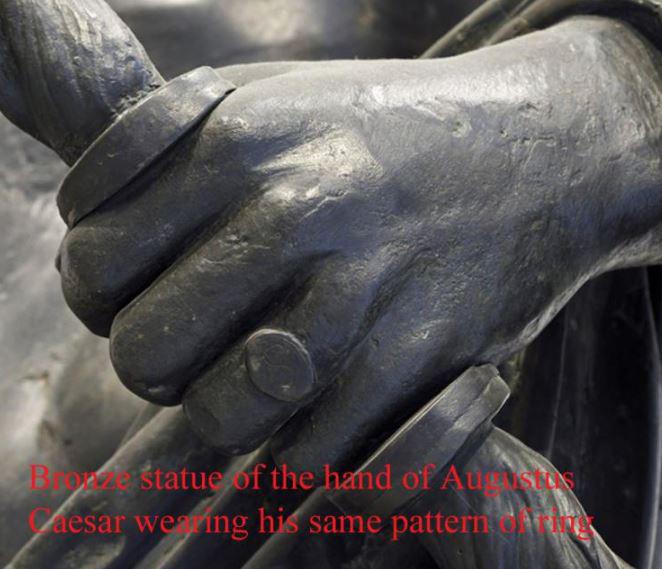1st Century Roman Bronze Ring, Engraved Intaglio of Goddess Minerva With Her Spear & Shield, Inlaid With Red Enamel. For Such As A Roman Centurion or An Equites
Henig type Xb. Although the surface is age worn one can see her helmeted head, spear and shield, and her shield and robe are decorated with inlaid red enamel.
This is a wonderful, high middle status ancient Roman ring, of centurion or equestrian quality, from the time of the Emperors Augustus, Tiberius, Caligula, Claudius & Nero.
Classified by the seminal classification of ancient ring forms, by Dr. Martin Henig, as Ancient Roman, Henig type Xb. Roman ring around 1900 years old. In copper bronze with great, natural age patination. Beautifully carved intaglio seal detail of wide oval bezel affixed to flattened shoulders engraved copper alloy, with a fair amount of aged surface russetting. Almost identical to one found in the UK, near Hadrian's Wall (but that example had no rare enamel work}. The ring was important for displaying the Roman's status. For example Tiberius, who was after all left-handed according to Suetonius, thus displays a ring in his bronze portrait as the Pontifex Maximus:
From a small collection of British recovered original Roman rings, all in excavated condition, found in the 19th century from the same location. Examples of this type can be found in Henig, M. (1974) A corpus of engraved gemstones from British Sites, British Archaeological Reports 8 (II): 90.
By the time of Claudius, equestrians {or equites} could reasonably expect an important and good career. After serving in the army as an officer, a potential equestrian might become a procurator – an agent of the emperor. He could then become a prefect, or government administrator, at home or abroad.
From the earliest times and throughout the Republican period and beyond, Roman equites subscribed, in their role as Roman cavalrymen, to an ethos of personal heroism and glory. This was motivated by the desire to justify their privileged status to the lower classes that provided the infantry ranks, to enhance the renown of their family name, and to augment their chances of subsequent political advancement in a martial society. For equites, a focus of the heroic ethos was the quest for spolia opima, the stripped armour and weapons of a foe whom they had killed in single combat. There are many recorded instances. For example, Servilius Geminus Pulex, who went on to become Consul in 202 BC, was reputed to have gained spolia 23 times
The bronze copper alloy is naturally aged over 2000 years to now present a natural green patination with surface encrustations. Originally it would have shone like gold. The carvings on rings and seals are known as Intaglio, and a seal ring was part of Roman society for nobles, military officers and citizens. They were personal signets, and the more valuable were made from a small gemstone, with a design cut into the surface by skilled craftsmen, and usually set within a ring. They were used to seal important documents, and objects by making an impression on soft clay or wax. Wearing a carved carnelian or jasper signet ring immediately showed that you were of rank, and thus had status, wealth and influence. Some surviving rings have been found across Roman Britain, in towns and military sites alike, including two at the Waddon Hill former Roman military fort site..
Athena, often given the epithet Pallas, is an ancient Greek goddess associated with wisdom, warfare, and handicraft who was later syncretized with the Roman goddess Minerva. Athena was regarded as the patron and protectress of various cities across Greece, particularly the city of Athens, from which she most likely received her name. The Parthenon on the Acropolis of Athens is dedicated to her. Her major symbols include owls, olive trees, snakes, and the Gorgoneion. In art, she is generally depicted wearing a helmet and holding a spear. The myth of Minerva's birth follows that of Athena. In it, Minerva was borne of Metis, who had been swallowed by Jupiter, and burst from her father's head, fully grown and clad in armour.
Jupiter had sex with the titaness Metis, which resulted in her attempting to change shape (or shapeshift) to escape him. Jupiter then recalled the prophecy that his own child would overthrow him, as he had Saturn, and in turn, Saturn had Caelus. Fearing that their child would be male, and would grow stronger than he was and rule the Heavens in his place, Jupiter swallowed Metis whole after tricking her into turning herself into a fly. The Titaness gave birth to Minerva and forged weapons and armour for her child while within Jupiter's body. In some versions of the story, Metis continued to live inside of Jupiter's mind as the source of his wisdom. Others say she was simply a vessel for the birth of Minerva. The constant pounding and ringing left Jupiter with agonizing pain. To relieve the pain, Vulcan used a hammer to split Jupiter's head and, from the cleft, Minerva emerged, whole, adult, and in full battle armour.
Augustus, Gaius Julius Caesar Augustus (born Gaius Octavius; 23 September 63 BC – 19 August AD 14), was also known as Octavian, and was the founder of the Roman Empire. He reigned as the first Roman emperor from 27 BC until his death in AD 14. The reign of Augustus initiated an imperial cult, as well as an era of imperial peace (the Pax Romana or Pax Augusta) in which the Roman world was largely free of armed conflict. The Principate system of government was established during his reign and lasted until the Crisis of the Third Century.
Tiberius Julius Caesar Augustus 16 November 42 BC – 16 March AD 37, was Roman emperor from AD 14 until 37. He succeeded his stepfather Augustus, the first Roman emperor. Tiberius was born in Rome in 42 BC to Roman politician Tiberius Claudius Nero and his wife, Livia Drusilla. In 38 BC, Tiberius's mother divorced his father and married Augustus. Following the untimely deaths of Augustus's two grandsons and adopted heirs, Gaius and Lucius Caesar, Tiberius was designated Augustus's successor. Prior to this, Tiberius had proved himself an able diplomat, and one of the most successful Roman generals: his conquests of Pannonia, Dalmatia, Raetia, and (temporarily) parts of Germania laid the foundations for the empire's northern frontier.
Caligula, Gaius Caesar Augustus Germanicus was Roman emperor from AD 37 until his assassination in AD 41. He was the son of the Roman general Germanicus and Augustus' granddaughter Agrippina the Elder, members of the first ruling family of the Roman Empire. He was born two years before Tiberius was made emperor. Gaius accompanied his father, mother and siblings on campaign in Germania, at little more than four or five years old. He had been named after Gaius Julius Caesar, but his father's soldiers affectionately nicknamed him "Caligula" ('little boot')
Caligula's sister, Agrippina the Younger, wrote an autobiography that included a detailed account of Caligula's reign, but it too is lost. Agrippina was banished by Caligula for her connection to Marcus Lepidus, who conspired against him. Caligula also seized the inheritance of Agrippina's son, the future emperor Nero. Gaetulicus flattered Caligula in writings also now lost. Suetonius wrote his biography of Caligula 80 years after his assassination, and Cassius Dio over 180 years after; the latter offers a loose chronology. Josephus gives a detailed account of Caligula's assassination and its aftermath, published around 93 AD, but it is thought to draw upon a "richly embroidered and historically imaginative" anonymous biography of Herod Agrippa, presented as a Jewish "national hero".286 Pliny the Elder's Natural History has a few brief references to Caligula, possibly based these on the accounts by his friend Suetonius, or an unnamed, shared source. Of the few surviving sources on Caligula, none paints Caligula in a favourable light. Little has survived on the first two years of his reign, and only limited details on later significant events, such as the annexation of Mauretania, Caligula's military actions in Britannia, and the basis of his feud with the Senate
Claudius, Tiberius Claudius Caesar Augustus Germanicus 1 August 10 BC – 13 October AD 54) was a Roman emperor, ruling from AD 41 to 54. A member of the Julio-Claudian dynasty, Claudius was born to Drusus and Antonia Minor at Lugdunum in Roman Gaul, where his father was stationed as a military legate. He was the first Roman emperor to be born outside Italy.
Nero Claudius Caesar Augustus Germanicus 15 December AD 37 – 9 June AD 68) was a Roman emperor and the final emperor of the Julio-Claudian dynasty, reigning from AD 54 until his death in AD 68.
Nero was born at Antium in AD 37, the son of Gnaeus Domitius Ahenobarbus and Agrippina the Younger (great-granddaughter of the emperor Augustus). Nero was three when his father died.1 By the time Nero turned eleven,2 his mother married Emperor Claudius, who then adopted Nero as his heir. Upon Claudius' death in AD 54, Nero ascended to the throne with the backing of the Praetorian Guard and the Senate. In the early years of his reign, Nero was advised and guided by his mother Agrippina, his tutor Seneca the Younger, and his praetorian prefect Sextus Afranius Burrus, but sought to rule independently and rid himself of restraining influences. The power struggle between Nero and his mother reached its climax when he orchestrated her murder. Roman sources also implicate Nero in the deaths of both his wife Claudia Octavia – supposedly so he could marry Poppaea Sabina – and his stepbrother Britannicus.
With his death, the Julio-Claudian dynasty ended. Chaos would ensue in the year of the Four Emperors.
During the era known as ancient Roman it became customary for all the senators, chief magistrates, and at last for the equites also, to wear seal status rings. The nature of their individual production meant that designs and details show a wide variety, though there are common themes, such as certain gods, which were especially popular.
The gallery contains photos of original Roman carved sculptures of the Goddess Athena { aka Minerva}, & the Emperor's Augustus, Tiberius, Caligula, Claudius and Nero
Every item is accompanied with our unique, Certificate of Authenticity. Of course any certificate of authenticity, given by even the best specialist dealers, in any field, all around the world, is simply a piece of paper,…however, ours is backed up with the fact we are the largest dealers of our kind in the world, with over 100 years and four generation’s of professional trading experience behind us
Code: 25584
475.00 GBP

